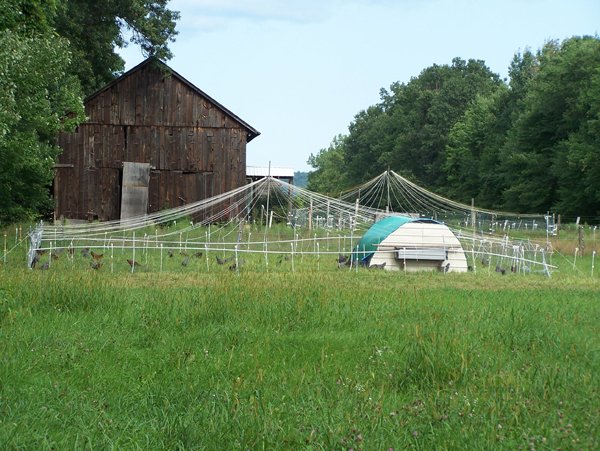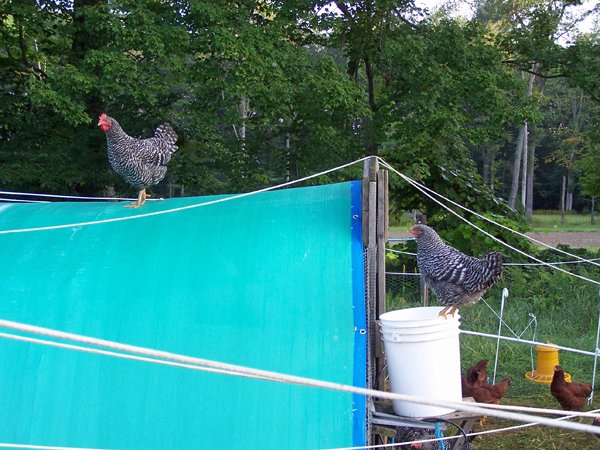
A week ago today I had to move this whole pen and my husband was laid up with the injured knees. A friend came out to help me move it. We got it done but it was exciting at times, especially working on the ladder to do the circus tent. It took us 3 hours to do.
Culling
On Friday she came out again. The event this time was culling all 75 birds to decide which ones would be the lucky layers for the new flock. It took us 1½ hours to do them. My husband was able to help a little as secretary, or administrative assistant, as he said.
Some interesting facts came out of the cull. When we moved the chicks out to this pen in June we counted 75 birds. We’d started with 90 we think, but don’t know, as the count when they arrived in May got messed up. There were supposed to be 60 Barred Rocks and 30 Buckeyes. I kept good records and show we lost 9, 6 Buckeyes and 3 Barreds. They are in a secure cage that nothing could get into, so we’ve no idea what happened to the other 6.
On Friday when we did the cull, we showed we now had 25 Buckeyes instead of 24, and 47 Barreds instead of 57. This is a total of 72, so we’ve lost 3 more, but never found any indication of predation. It’s a puzzle…

Think this has anything to do with the low count??
The cull was another surprise. I use colored bands to indicate quality. The physical features I am checking on each bird is the width between the pelvic bones and the depth of body between the pelvic bones and the keel. I use my fingers for measuring.
I also look at comb quality. As these are immature birds at 17 weeks, I must take the immaturity into consideration.
The bands:
Red, the best:
Barred: 1 finger between pelvic bones
3½ fingers between pelvic and keel
Buckeye: 1 finger between pelvic bones
3 fingers between pelvic and keel
(Buckeyes mature later, so I’m giving them a little slack.)
Pink, pretty good:
Barred: ½ finger between pelvic bones
3 fingers between pelvic and keel
Buckeye: ½ finger between pelvic bones
2½ fingers between pelvic and keel
Blue: there were a few who didn’t quite make the top grades, but we wanted to have enough birds for a flock of 18, so we used this color for these.
The Results:
Barreds:
Red: 4
Pink: 3
Blue: 2
Rejects: 37
Rooster: 1
Total: 47
Buckeyes:
Red: 5
Pink: 5
Blue: 2
Rejects: 13
Total: 25
This was a big surprise! The Buckeyes we had thought were doing not very well, regarding putting weight on and growing. But when we handled each bird, it turns out they did better than the Barreds!
The other thing we found was that there were 3 Barreds that measured up so poorly we labeled them, No body. They were barely ½ finger for pelvic and barely 1½ fingers for keel/pelvic. None of the Buckeyes were that bad.
On a mature bird, you would be looking for 2 – 3 fingers for pelvic and 4 - 5 fingers for pelvic/keel. At 17 weeks you would expect at least 2 fingers for a Barred Rock. We would, of course, reject this for a layer in our flock.
The New Flock:
Buckeyes: 10
Barred Rocks: 7
Susan the pet Barred: 1
Total: 18
The 4 blue banded birds will be sold to a family that helps with Freezer Camp.
This morning my husband and I moved the pen again, and it only took an hour. There’s 1 more weekly move, next Saturday, so we are catching chickens in a clean pen on Sunday. After that the 18 lucky birds will have that big pen to themselves and no rooster pestering them. We will move it every 2 weeks, and the coop every 2 days until mid October.
